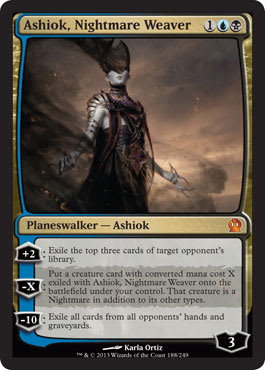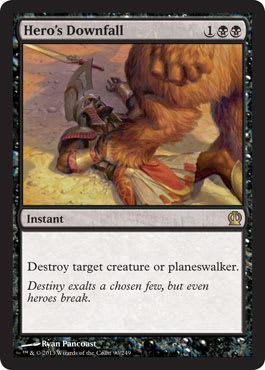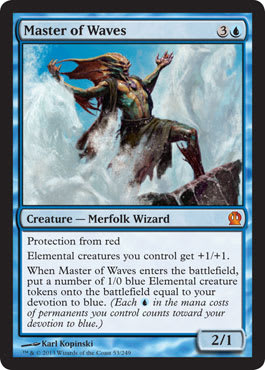Last week, I ventured back onto Magic Online (MTGO) for my article, and overall, the response seemed positive, as it seems many people are looking to the digital as of late to allow them an easier time finding a place in their busy days for their hobby. I wanted to wait a few weeks to talk about MTGO again, but as it ties in very well with what I will be covering this week, I am forced to return to the digital.
As I mentioned last week, I have turned to MTGO recently to allow myself a reprieve from busy events and a constant lack of ability to actually play Magic. After the event in Toronto a few weeks ago, I have had much more interest in not only playing MTGO on a more frequent basis, but also to begin a real collection as a player—not a financier.
I asked myself what was the simplest way to get into Magic Online while not having to invest major amounts of money at one time. I settled on Limited, as it was my stronger format anyway; I should mention that until I qualified for the Pro Tour, I played almost no competitive Constructed Magic outside of the games of Five Color. So, once I decided on sticking to Draft, I sold almost everything I opened unless it was glaringly cheap—in that case, I held for a spike and sold then. This does not equate to sustainability, as you can imagine, as I was a solid player but nowhere near the caliber to live the dream solely on Limited.
So, that brings us to a convergence this week of my history on Magic Online and the current state of Standard as an affordable format. I am now more dedicated to collecting as a player on Magic Online, and I realized that, overall, the prices of cards are fairly stable if you watch the market even just a few times a week. This means you not only have the ability to check immediately during events with real-time updating to bot prices, but you also have an immediate out with none of the buy-listing or auction-site hassle.
As I talked about last week, the less time you have to devote to the financial end and sustaining your collection, the more time you have to actually play the game we all love. If you are primarily interested in Standard, it is best to take a good look at MTGO when you are evaluating how to approach the next year. Beyond all of the obvious advantages of MTGO, Standard is particularly forgiving to those who are willing to be patient. Next week, I will talk about what to do if you are looking to sustain a Standard collection without playing online, but for this week, I am going to concentrate on what to do if you are sticking to physical cards.
If you haven’t read last week’s article, a link can be found here, and I highly suggest it, as I will be referencing it throughout. I have found that being flexible and investing in Block while the prices are down right before redemption is best. Then, hold what you have and playing Block to grind value, and throw together any cheap Standard decks you can in the first year.
Once you have managed to obtain your set of the past block—which is not as difficult as you would think if you buy in correctly—you can then be ready for the following year’s Standard. Not only does this prepare you in the availability department, as you now have access to everything, you also have a leg up in the new format since you have been grinding Block the previous year. For anyone who has not played Block, it can be a fairly solid format most years. I am enjoying the viability of five to ten decks with no clear victor in power level. Like Standard, there are years when Block can be limited in the number of viable decks, but this also shows you how powerful an interaction is if the entire format revolves around it. This information can be invaluable going into the following year, as you have a solid starting point for where to begin testing.
Beyond the availability of cards, there is also the added benefit to both have the ability to test immediately, whether it be for gain or purely for experience. Another added benefit of investing in MTGO is that you only need a maximum of four cards to be able to assemble countless decks. This may not seem like a huge deal, but anyone who runs a gauntlet during a new format’s birth knows it can be annoying to sleeve up a number of decks and either have to proxy or acquire more than a play set of some cards. This can also be handy when you are testing with a familiar player, as you can lend him or her cards so that player can then play anything. That means, at most, you would only need to each acquire a play set of card that would otherwise overlap.
With all of the added benefits, there, of course, comes some downside. In this case, that’s the loss of face-to-face play. This is a major part of most high-level players’ games, as the ability to read reactions and glean information can be fundamental in winning some close games. With this lack of information, it is necessary to play as tight as possible and be sure to track any information you may have been given, such as odd tapping or reveals. Writing down cards you know your opponent has is an old trick, and it’s one everyone should live by. And in the case of MTGO, it can be as easy as typing it into chat.
Another disadvantage to some is the inability of the opponents to miss triggers. I look at this with a positive outlook and treat it as though my opponents would play this well in person and that I should not rely on my opponents playing incorrectly. This can also be a boon for you if you treat this as a form of testing when you are playing. I began announcing far more of my triggers and missing far fewer subtle interactions when I shifted to MTGO, and I believe seeing a turn-by-turn, step-by-step layout can help many people who may be overwhelmed with some interactions in person.
With all the advantages as a player, it is important to note that the market is much more bullish with prices, as everything is almost always very close in price across multiple vendors—or, in this case, bots. This prevents you from making much value when you are buying and selling cards without just letting the format do the work. Unlike real life, most cards that would be casual staples are worth nothing, as the majority of players are aimed toward competitive testing. On this note, it is also important to buy into any of these bulk cards that may see play, as the market can rise at any time, and once it does, there is very little chance at finding those cards at the previous value.
With expensive cards, I will usually wait until just before redemption, when prices seem to be the lowest. In some cases, such as with Master of Waves, it would have been correct to buy in immediately, but that only applies to a select number of cards. While buying is usually on a time structure, selling out has less of a set schedule, as only cards in favor will be worth a good value as they draw closer to rotation. Knowing when to sell out of certain cards well before rotation is important, but if you are looking to keep playing until the end of the format, I suggest at least selling anything you don’t need and consolidating to one or two Standard decks. This minimizes risk of the cards dropping too hard and of you losing money. If you follow this pattern, you will probably find yourself paying for the majority of your future formats while still getting plenty of actual playing and testing in.
Before I depart this week, I want to recap a schedule to follow to maximize your ability to “go infinite.” Starting at the beginning of the season right after the first set, it is best to buy into any mythics you feel are underpriced and any rares that may be playable and hit bulk. As redemption approaches, it is best to buy the remainder of your mythics and finish any rares you haven’t purchased. Repeat this process for almost every set to acquire your play sets through the year. If you feel a card is overpriced, wait—it is unlikely to spike too much more as opposed to its potential to drop. During this time, you can play the current Block format as well as Standard up through the Pro Tour Qualifier season during the summer. Once you approach the beginning of the summer, I suggest selling anything you are no longer in need of for the remainder of the format that will be rotating. During this time, continue to play Block until the new season begins, and rinse and repeat.
In a future article, I will continue this methodology and apply it toward other formats as I experiment and find what works and what doesn’t, but it seems that Modern also has a similar rotation pattern for prices that can be used over a few years to cement yourself in the format and build a sizable collection. This is slightly more dangerous due to the random throwback formats that pop up, but I am sure there is still a fairly safe system. Join me next week, when I apply my knowledge of Standard to paper cards and explain the differences in where and when to buy compared to the digital market. Thank you, as always, for reading, and enjoy your holiday season!
Ryan Bushard



























